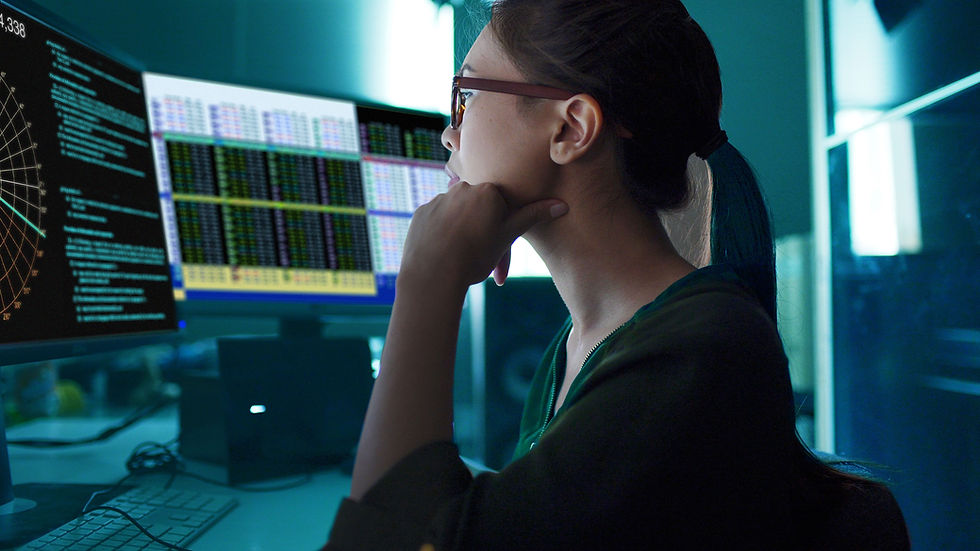Enhancing Your Telehealth Setup: Affordable Upgrades for Better Video and Audio Quality
- David Larsen
- Aug 6, 2024
- 6 min read
Updated: Aug 8, 2024

Vol. 1, No. 24 | August 6, 2024 | By Dave Larsen, Väsentlig Consulting LLC
As a home-based solo mental health practitioner using telehealth, the quality of your video and audio can significantly impact the effectiveness and professionalism of your sessions (Gough & Rosenfeld, 2019).
While you may have started with a basic setup, investing in affordable upgrades can enhance your virtual presence, improve communication with your clients, and create a more engaging and impactful therapeutic experience (Pierce et al., 2020).
In this post, we'll explore cost-effective ways to upgrade your telehealth setup for better video and audio quality.
The Importance of Video and Audio Quality in Telehealth
Video and audio quality are critical components of effective telehealth communication (Morland et al., 2020). High-quality video allows for clear visual cues, such as facial expressions and body language, which are essential for building rapport and assessing your clients' emotional states (Gough & Rosenfeld, 2019). Similarly, clear and uninterrupted audio ensures that you and your clients can understand each other easily, without the frustration of repeated requests for clarification or the strain of trying to decipher muffled speech (Pierce et al., 2020).
Poor video and audio quality can have several negative consequences for telehealth sessions:
Reduced Engagement: Pixelated, blurry, or freezing video and choppy, echoing, or low-volume audio can be distracting and disengaging for both you and your clients (Morland et al., 2020). This can lead to decreased attention, reduced participation, and a less effective therapeutic experience overall (Gough & Rosenfeld, 2019).
Impaired Communication: Poor video and audio quality can impair your ability to accurately perceive and respond to your clients' verbal and nonverbal cues (Pierce et al., 2020). This can lead to misunderstandings, missed opportunities for intervention, and a weakened therapeutic alliance (Morland et al., 2020).
Decreased Professionalism: Low-quality video and audio can make your telehealth setup appear unprofessional or ineffective, which can undermine your credibility and expertise in the eyes of your clients (Gough & Rosenfeld, 2019). This can lead to reduced trust, engagement, and ultimately, less successful therapeutic outcomes (Pierce et al., 2020).
By investing in affordable upgrades to your video and audio setup, you can mitigate these negative consequences and create a more professional, engaging, and effective telehealth experience for your clients (Morland et al., 2020).
Affordable Video Upgrades
While most modern laptops, tablets, and smartphones come with built-in cameras, the quality of these cameras can vary greatly (Gough & Rosenfeld, 2019). If you find that your built-in camera produces blurry, pixelated, or poorly lit video, consider the following affordable upgrades:
External Webcam: An external webcam can provide a significant improvement in video quality over most built-in cameras (Pierce et al., 2020). Look for webcams with at least 720p resolution (ideally 1080p), autofocus, and a built-in microphone. Good options are available for under $100 (Morland et al., 2020).
Ring Light: Adequate lighting is essential for clear and professional-looking video (Gough & Rosenfeld, 2019). A ring light is a circular light that provides even, diffused lighting for your face, reducing shadows and enhancing your appearance on camera. Affordable options can be found for under $50 (Pierce et al., 2020).
Tripod or Stand: A tripod or stand can help stabilize your camera and ensure a consistent, professional angle for your video (Morland et al., 2020). Look for a tripod or stand that is compatible with your external webcam or ring light and offers adjustable height and angle settings. Affordable options are available for under $30 (Gough & Rosenfeld, 2019).
By combining an external webcam, ring light, and tripod or stand, you can significantly enhance the quality and professionalism of your video for less than $200, a worthwhile investment for any home-based solo mental health practitioner using telehealth (Pierce et al., 2020).
Affordable Audio Upgrades
While video quality is important for telehealth, audio quality is arguably even more critical (Morland et al., 2020). Poor audio can lead to frustration, misunderstandings, and disengagement, while clear and uninterrupted audio can facilitate effective communication and a strong therapeutic alliance (Gough & Rosenfeld, 2019). Consider the following affordable audio upgrades:
External Microphone: An external microphone can provide a significant improvement in audio quality over most built-in microphones (Pierce et al., 2020). Look for microphones with noise-canceling features, adjustable gain settings, and a USB connection for easy setup. Good options are available for under $100 (Morland et al., 2020).
Headphones or Headset: Using headphones or a headset can help reduce echo, feedback, and background noise, while also providing clearer audio for both you and your clients (Gough & Rosenfeld, 2019). Look for headphones or headsets with noise-canceling features, comfortable ear cushions, and a built-in microphone for convenience. Affordable options are available for under $50 (Pierce et al., 2020).
Acoustic Treatments: While not strictly necessary, acoustic treatments can help reduce echo, reverberation, and background noise in your telehealth space (Morland et al., 2020). Simple DIY solutions, such as hanging blankets or curtains on bare walls or placing a rug on a hard floor, can make a noticeable difference in audio quality. For a more professional solution, consider affordable acoustic panels, which can be found for under $100 (Gough & Rosenfeld, 2019).
By investing in an external microphone, headphones or headset, and basic acoustic treatments, you can significantly improve the audio quality of your telehealth sessions without breaking the bank (Pierce et al., 2020).
Optimizing Your Telehealth Environment
In addition to upgrading your video and audio equipment, optimizing your telehealth environment can also enhance the quality and professionalism of your sessions (Morland et al., 2020). Consider the following affordable strategies:
Dedicated Space: If possible, set up a dedicated space in your home for telehealth sessions, separate from your personal living areas (Gough & Rosenfeld, 2019). This can help reduce distractions, improve privacy, and create a more professional atmosphere for your clients (Pierce et al., 2020).
Neutral Background: Choose a neutral, uncluttered background for your video that won't distract from your sessions (Morland et al., 2020). A plain wall, bookshelf, or simple artwork can provide a professional backdrop without drawing attention away from the therapeutic process (Gough & Rosenfeld, 2019).
Adequate Lighting: In addition to a ring light for your face, ensure that your telehealth space has adequate overall lighting to create a warm and inviting atmosphere (Pierce et al., 2020). Natural light from windows, supplemented by soft, diffused artificial light, can help create a comfortable and professional environment for your sessions (Morland et al., 2020).
Minimizing Distractions: Take steps to minimize distractions during your telehealth sessions, such as silencing notifications on your devices, closing unnecessary applications, and ensuring that family members or pets won't interrupt your sessions (Gough & Rosenfeld, 2019). Consider using a "Do Not Disturb" sign on your door or a white noise machine to reduce external noise (Pierce et al., 2020).
By optimizing your telehealth environment, you can create a professional and inviting space that enhances the quality and effectiveness of your sessions, without the need for expensive renovations or equipment (Morland et al., 2020).
Conclusion
Investing in affordable upgrades for your video and audio setup, as well as optimizing your telehealth environment, can significantly enhance the quality and effectiveness of your sessions as a home-based solo mental health practitioner. By providing clear visual and auditory communication, you can create a more engaging and impactful therapeutic experience for your clients, while also demonstrating your professionalism and expertise.
Remember, upgrading your telehealth setup is an ongoing process, and you don't need to make all the changes at once. Start with the most critical improvements, such as an external webcam or microphone, and gradually add additional upgrades as your budget and needs allow. Regularly assess the quality of your video and audio, seek feedback from your clients, and stay informed about new technologies and best practices in the field.
By prioritizing the quality of your telehealth setup, you are not only investing in your own professional development but also in the well-being and satisfaction of your clients. With clear video, uninterrupted audio, and a professional and inviting environment, you can create a virtual therapeutic space that rivals the effectiveness and impact of in-person sessions.
References
Gough, F., & Rosenfeld, J. (2019). Video conferencing in psychology training and practice: A review of the literature. Australian Psychologist, 54(2), 88-97. https://doi.org/10.1111/ap.12375
Morland, L. A., Mackintosh, M. A., Glassman, L. H., Wells, S. Y., Thorp, S. R., Rauch, S. A. M., Cunningham, P. B., Tuerk, P. W., Grubbs, K. M., Golshan, S., Sohn, M. J., & Acierno, R. (2020). Home-based delivery of variable length prolonged exposure therapy: A comparison of clinical efficacy between service modalities. Depression and Anxiety, 37(4), 346-355. https://doi.org/10.1002/da.22979
Pierce, B. S., Perrin, P. B., & McDonald, S. D. (2020). Demographic, organizational, and clinical practice predictors of U.S. psychologists' use of telepsychology. Professional Psychology: Research and Practice, 51(2), 184-193. https://doi.org/10.1037/pro0000267
Roesler, C. (2021). A meta-analysis on the effectiveness of telehealth cognitive behavioral therapy for anxiety disorders. Cognitive Behaviour Therapy, 50(3), 191-216. https://doi.org/10.1080/16506073.2020.1823514
Vincent, C., Barnett, M., Killpack, L., Sehgal, A., & Swinden, P. (2017). Advancing telecommunication technology and its impact on psychotherapy in private practice. British Journal of Psychotherapy, 33(1), 63-76. https://doi.org/10.1111/bjp.12267




Comments